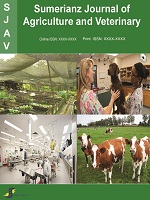Sumerianz Journal of Agriculture and Veterinary

Online ISSN: 2617-3077
Print ISSN: 2617-3131
Quarterly Published (4 Issues Per Year)
Journal Website: https://www.sumerianz.com/?ic=journal-home&journal=30Archive
Volume 3 Issue 8 (2020)
Challenges of Poultry Farming In Makurdi Benue State, North-Central Nigeria
Authors : Leo Daniel Ojabo ; Tokshidung Rittongwe Yilji ; Ibrahim Adah Okachi
DOI : doi.org/10.47752/sjav.38.116.122
Abstract:The study assessed challenges of poultry production in Makurdi Area of Benue State, North Central Nigeria. Information on production activities, management and problems were collected from 50 poultry farmers in the study area using structured questionnaire and assessment through direct observations. The data were analyzed using tables, frequency distribution and percentages. From the analysis, the poultry enterprises are confronted with a number of constraints mitigating against their efficient operation. Majority (66%) of the poultry farms in Makurdi were of low to medium scale with flock size of < 1000 birds. The problems of low capital, high input costs, diseases and adverse weather conditions were identified in the study area. High cost of feeds and at times scarcity of layer feeds are major problems. They also identified proper marketing outlets especially for broiler sales. All these problems can be tackled by making loans/grants easily accessible by the government and encouraging farmers to organise themselves into cooperatives. By so doing their resources can be pooled together for meaningful development of their farms and the poultry industry in Benue State. Extension services should include creating awareness of the importance of biosecurity measures on farms in order to limit infections.
A Review of Aquaculture Production in Tanzania; Recent Status, Challenges and Opportunities, and Its Impact in Poverty Alleviation
Authors : Sebastian S. Mosha ; John M. Daudi
DOI : doi.org/10.47752/sjav.38.107.115
Abstract:Tanzania endowed with abundant water resources with a huge potential to develop marine and freshwater aquaculture. Efficient utilization of these resources are required as the demand of fish is increasing with increase in the population of an average of 2.47% per year. Due to that, a gap between fish supply and demand is widening which in turn causes low fish protein supply leading to malnutrition. To bridge this gap, several strategies have been implemented by the government including fish importation to supplement fish shortage in country. However, this strategy seems to be unable to satisfy the fish demand of the large population due to high importation costs. Therefore, a review was conducted to explore recent aquaculture production in Tanzania, challenges and opportunities, different strategies implemented, as well as impacts in poverty alleviation. Several government reports and online-published papers were explored. Therefore, this review indicates a remarkable increased in fish production due to fish species diversification, government support and private sector investment. Hence, provide more opportunities to the people to be employed and earn money, as well as availability of protein from fish to improve their nutrition status. In addition, this review suggest some areas to be emphasized including; development of technology and investment in seeds and feeds production, investigation of alternative protein sources for fish, policies harmonization, and financing mechanism development.



